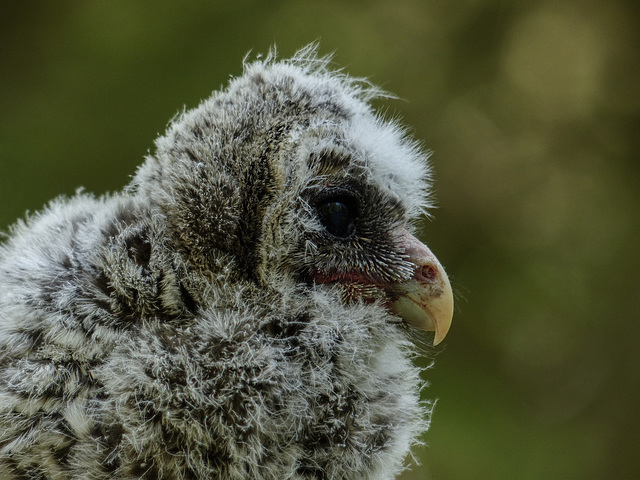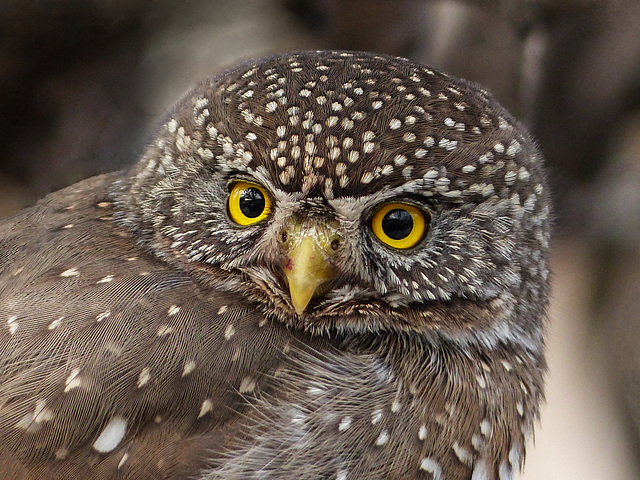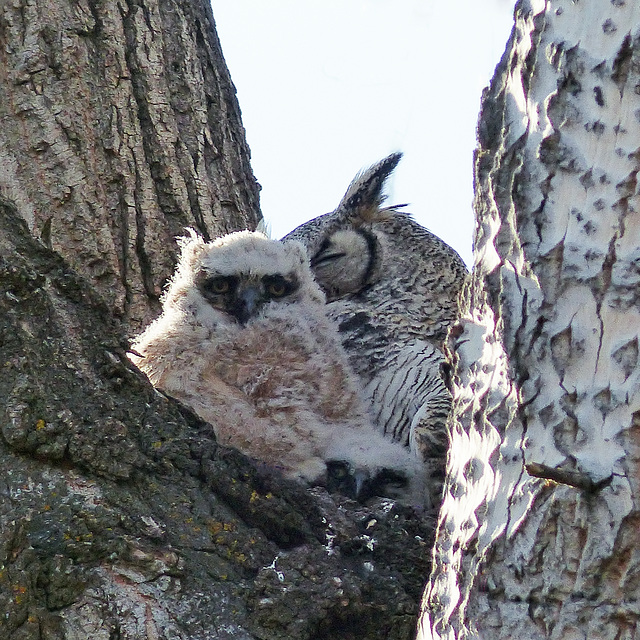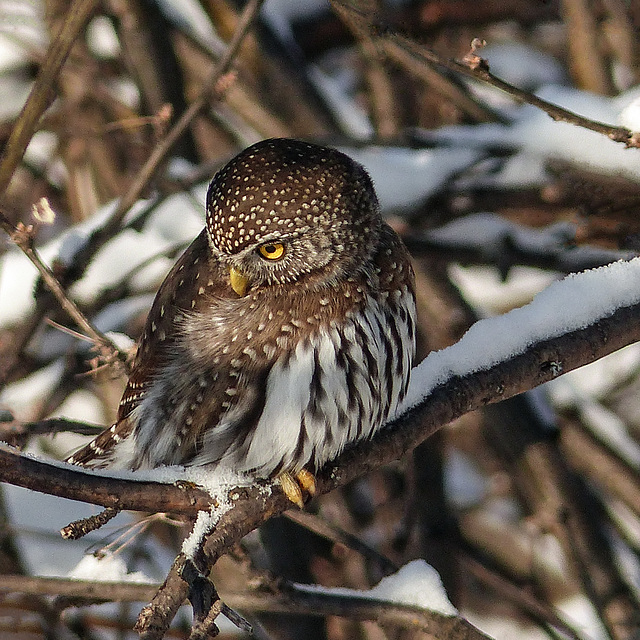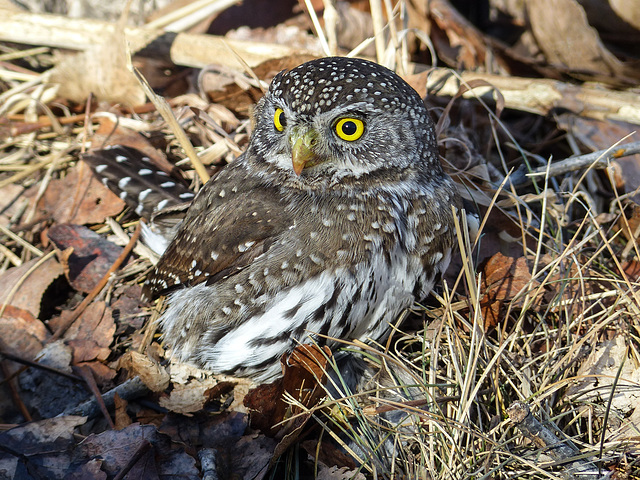
Owls 3
29 Mar 2015
Safe with Mom
I'm finding it hard to get motivated to go through my archives and somewhat more recent photos at the moment. I've taken very few photos during the past month and few are remotely inspiring. I really need to get out, period, and definitely need some new places to explore. Our weather forecast has a mix of snow and rain or scattered flurries on three days this coming week, but today is supposed to be OK, so I might go for a drive.
Yesterday, I went on a two-hour walk in the afternoon with birding friends. This was down in South Glenmore Park, along the edge of the Glenmore Reservoir, looking right across to the windmill in Heritage Park. I always like seeing the small, blue and white mill in the far distance. Most of the Reservoir is still ice-covered and at this stage, the melting ice is a beautiful turquoise colour.
Very quiet as far as birds were concerned, just the "usual" Chickadees, Ravens, Canada Geese and so on. I think the "highlights" were a Hairy Woodpecker (which only one of us actually saw) in the wooded area, and eight Swans that were on the far side of the Reservoir - too far away to see if they were Tundra or Trumpeter.
After our walk, we went to Tim Horton's for coffee and a good chat. Always really enjoyable. On the way home, I called in at Fish Creek Park for ten minutes, to see if I could see this Great Horned Owl and either of her babies (someone had said that there were two). I was in luck, as one of the owlets put its head up for a few seconds. The light was really bad and the owls are quite high up in the tree, but at least I saw the little one for the first time. This was only the second time I had seen the adult on her nest, too. I was amazed that no one else was there, lol, which was good to see. Or maybe they were there earlier in the day.
04 Jun 2013
Baby Barred Owl
This is a three-week-old Barred Owlet, really just a bundle of fluff that was too young to do anything : ) It and its only sibling were carefully shown to a group of us bird lovers and photographers, so this is not a "natural" photo, but a posed one.
On 4 June 2013, we had such a great day! I had been invited (and could bring a couple of friends) to go and see a family of tiny Northern Saw-whet Owls (with 6 owlets) and a family of Barred Owls (2 owlets) on private land up near Edmonton. It's a three-hour drive from Calgary north to Edmonton, and then the owls were a further half-hour drive. (We had just a very short drive between the two owl familes). Worth every minute of it to see these two species of beautiful owls! Thanks so much, Rob, for driving Phil and me up there.
The owls were a little younger than they might have been, but still so precious to see! As usual, we felt so privileged to get this wonderful chance! Richard showed us two of the six Saw-whet babies (and banded one of these that he hadn't yet banded), and both the Barred Owlets. One of the Saw-whets was only about a week old and the other was three weeks old. The Barred Owlets were very much bigger than the Saw-whets. The female adults of both families were high in fairly near, tall trees while this was going on, so we were very lucky to get photos of them, too. Trying to remember - I think I've only ever seen two Saw-whet owls in the wild, and this was the very first time I'd ever had the chance to see a Barred Owl in the wild : ) At long, long last - and it felt so good! I also got the chance to meet several people from Flickr, including Don Delaney and part of his "gang". Richard - we can't thank you enough for what you do (as a licenced Raptor Bander) and for sharing your love and knowledge of wildlife with others.
www.allaboutbirds.org/guide/Barred_Owl/id
en.wikipedia.org/wiki/Barred_Owl
31 Mar 2015
Dad on guard duty
Yesterday morning, I went on a birding walk with a group of friends, to Fish Creek Park. When owls are seen, they tend to be the highlight of a walk, and yesterday we were able to see six Great Horned Owls, 4 adults and 2 young ones.
The owl in this photo is a male, Dad to three young ones. We only saw two of the babies yesterday morning - this was the first time I had seen two. I had only been to see these owls once before. As males always do, they perch and rest in a tree that has a good view of the nest, keeping watch over the female and the babies. Even though this owl looks like he's fast asleep, he will be wide awake in a split second if anything, such as a Canada Goose, threatens the nest.
"With its long, earlike tufts, intimidating yellow-eyed stare, and deep hooting voice, the Great Horned Owl is the quintessential owl of storybooks. This powerful predator can take down birds and mammals even larger than itself, but it also dines on daintier fare such as tiny scorpions, mice, and frogs. It’s one of the most common owls in North America, equally at home in deserts, wetlands, forests, grasslands, backyards, cities, and almost any other semi-open habitat between the Arctic and the tropics.
Great Horned Owls are nocturnal. You may see them at dusk sitting on fence posts or tree limbs at the edges of open areas, or flying across roads or fields with stiff, deep beats of their rounded wings. Their call is a deep, stuttering series of four to five hoots." From AllAboutBirds.
www.allaboutbirds.org/guide/Great_Horned_Owl/id
en.wikipedia.org/wiki/Great_horned_owl
24 Jan 2015
2 favorites
Eyes like Licorice Allsorts
Saturday, 24 January 2015, was a great day for seeing the tiny, popcan-sized Northern Pygmy-owl in Fish Creek Park. This species is rare to uncommon in Alberta. For once, I was up really early so that I could go on a birding walk, which was being held at the same location. Other than the usual Black-capped Chickadee. Nuthatches and Downy Woodpeckers, the two main species that we saw were the Pileated Woodpecker (a male and a female together) and a very distant Cooper's Hawk. When we were at the furthest spot, we got news that the Northern Pygmy-owl had appeared. When we got back to the start, we found a lot of photographers who were all lined up with their enormous camera lenses pointed upwards.
After getting back to where the owl was and seeing it on several different branches that were not particularly easy to photograph, it suddenly flew down to the mass and tangle of bushes right where all the photographers were standing. A few people knelt or lay down in the cold, melting snow so that they could get a better view through the thin branches. There was no way I could do that, so my view was not good. However, as far as actually seeing the owl at such close quarters was concerned, it was a great chance. All my photos, except this one and maybe two or three others, were no good at all and need to be deleted : ( It was amazing to see this tiny bird of prey up close, and it was really good to see how at ease it seemed. Most definitely a case of the owl coming to where we were, and not a case of photographers trying to get as close as possible. I did remove a very thin branch that lay over the forehead, close to the eye on the left. Can't remember if the owl had just caught a Meadow Vole before I took these photos or whether it caught one and then flew up into a thin, forked branch where it posed beautifully along with its catch.
Eventually, it was time to go home, especially as I had originally come to the park for the 3-hour bird walk. Some people do this all the time and I don't know how they manage to do it. It requires so much patience, and an awful lot of "free" time.
"Northern Pygmy Owls are 'sit and wait' predators, that hunt mainly by vision, diving down onto prey on the ground and driving the talons into the prey's throat. They will also attack birds in shrubs, crashing into the hapless victims. Most prey is carried off in the feet to feeding sites. Birds are usually plucked before being consumed. They often eat only the brains of birds and the soft abdomen of insects. One of these little owls can carry prey weighing up to 3 times its own weight.
The Northern Pygmy Owl feeds on a wide range of small prey including small mammals, birds, and reptiles and amphibians. Voles make up the bulk of their diet, with birds comprising most of the rest (mainly songbirds, but as large as a California Quail). Other small mammals include shrews, mice, chipmunks, bats, moles, young rabbits, and weasels. Insects may be very important when they are most abundant. Other prey taken are toads, frogs and small lizards and snakes.
During winter, surplus prey is cached in a cavity, often in large quantities. Summer caches are usually much smaller.
Pellets are very small, averaging about 3cm long. They are formed only occasionally as these owls don't consume large amounts of fur, feathers, or bone. The pellets tend to fall apart shortly after ejection." From OwlPages.
www.owlpages.com/owls.php?genus=Glaucidium&species=ca...
31 Mar 2015
"Two (owlets) out of three ain't bad"
I find my eyes go straight to the wide-open eyes of the biggest owlet in this photo. Be careful not to miss a younger one with just part of its little face showing above the nest edge : ) Somewhere, there is a third owlet that could not be seen just then - we only stayed a few minutes. I had only been to see these owls once before and at that time was only able to see one owlet. Maybe if/when I visit them again, all three owlets will be visible. Hopefully, I will see them again at a time when the light is much better, too.
That day, 31 March 2015, I went on a birding walk with a group of friends, to Fish Creek Park. When owls are seen, they tend to be the highlight of a walk, and on this walk we were able to see six Great Horned Owls, 4 adults and 2 young ones.
The other day, I posted a photo of Dad, who was sitting in a nearby Spruce tree, looking like he was fast asleep. As males always do, they perch and rest in a tree that has a good view of the nest, keeping watch over the female and the babies. Even though the male looks like he's fast asleep, he will be wide awake in a split second if anything, such as a Canada Goose, threatens the nest.
"With its long, earlike tufts, intimidating yellow-eyed stare, and deep hooting voice, the Great Horned Owl is the quintessential owl of storybooks. This powerful predator can take down birds and mammals even larger than itself, but it also dines on daintier fare such as tiny scorpions, mice, and frogs. It’s one of the most common owls in North America, equally at home in deserts, wetlands, forests, grasslands, backyards, cities, and almost any other semi-open habitat between the Arctic and the tropics.
Great Horned Owls are nocturnal. You may see them at dusk sitting on fence posts or tree limbs at the edges of open areas, or flying across roads or fields with stiff, deep beats of their rounded wings. Their call is a deep, stuttering series of four to five hoots." From AllAboutBirds.
www.allaboutbirds.org/guide/Great_Horned_Owl/id
en.wikipedia.org/wiki/Great_horned_owl
05 Feb 2011
Northern Pygmy-owl from 2011
I came across this photo of a tiny, popcan-sized Northern Pygmy-owl from my archives the other day and thought I'd post it. It was taken on 5 February 2011, in Fish Creek Park. Can't help wondering if this owl is the same owl as one of the ones that have been in Fish Creek Park during January and February of this year (2015). I think it has to be.
On the day I took this photo, I had bumped into a group of friends when I arrived at the parking lot and they told me they had seen the owl. Well, it took a lot of looking, I can tell you! When I finally did spot it, it was towards the top of probably the tallest tree in the area, but it eventually flew to the other side of the path, to the top of the second tallest tree. Again it flew and disappeared. After looking and looking and looking, there it was, not too far away, but in a tree with a tangle of small branches, thankfully with none across the owl itself. These little fist-sized/popcan-sized owls are just about impossible to find : ) I think this was only about the third time I'd had any fresh air at all in the previous 5-6 weeks, which was so bad and, though sunshine would have been really nice, I'm sure the short walk did me some good. The owl certainly did : ) These little guys are just so beautiful - and fierce! They are rare to uncommon here in Alberta.
"Northern Pygmy Owls are 'sit and wait' predators, that hunt mainly by vision, diving down onto prey on the ground and driving the talons into the prey's throat. They will also attack birds in shrubs, crashing into the hapless victims. Most prey is carried off in the feet to feeding sites. Birds are usually plucked before being consumed. They often eat only the brains of birds and the soft abdomen of insects. One of these little owls can carry prey weighing up to 3 times its own weight.
The Northern Pygmy Owl feeds on a wide range of small prey including small mammals, birds, and reptiles and amphibians. Voles make up the bulk of their diet, with birds comprising most of the rest (mainly songbirds, but as large as a California Quail). Other small mammals include shrews, mice, chipmunks, bats, moles, young rabbits, and weasels. Insects may be very important when they are most abundant. Other prey taken are toads, frogs and small lizards and snakes.
During winter, surplus prey is cached in a cavity, often in large quantities. Summer caches are usually much smaller.
Pellets are very small, averaging about 3cm long. They are formed only occasionally as these owls don't consume large amounts of fur, feathers, or bone. The pellets tend to fall apart shortly after ejection." From OwlPages.
www.owlpages.com/owls.php?genus=Glaucidium&species=ca...
31 Jan 2015
Northern Pygmy-owl on snowy branch
Called in at the local park in the afternoon of 31 January 2015, for maybe an hour. That was all I could stand, it was SO cold, plus most of the area was then in the shade. It was only -13C (windchill -15C), but it felt so much colder than that. I wasn't sure whether I was going to be able to go, as both my front car door locks had frozen solid and I had to wait for the lock de-icer spray to hopefully work.
Friends who had been there for much longer told me that the tiny Northern Pygmy-owl had been high in the trees the whole time they had been there. While I was there, we had a few moments when the owl flew down into the bushes - a mass of tangled branches that result in a "messy" photo, but still better than none. If you were lucky, you might find a small gap with no branches in front of the owl. It had snowed two nights earlier, so it made a change to see the bird in a snowy setting. My point-and-shoot has 48X zoom - this shot was taken at Focal Length (35mm format) - 1200 mm.
"The Northern Pygmy-Owl may be tiny, but it’s a ferocious hunter with a taste for songbirds. These owls are mostly dark brown and white, with long tails, smoothly rounded heads, and piercing yellow eyes. They hunt during the day by sitting quietly and surprising their prey. As a defensive measure, songbirds often gather to mob sitting owls until they fly away. Mobbing songbirds can help you find these unobtrusive owls, as can listening for their call, a high-pitched series of toots." From AllAboutBirds.
www.allaboutbirds.org/guide/Northern_Pygmy-Owl/id
en.wikipedia.org/wiki/Northern_pygmy_owl
22 Feb 2015
Did anyone see what I caught?
On 22 February 2015, we got another chance to see the tiny, popcan-sized Northern Pygmy-owl in Fish Creek Park. When I arrived, people who had been there for some time had already found the owl, perched in a smallish tree, but within a very short time, it suddenly flew down to where we were standing, maybe six feet away from my feet. You can just see a bit of the little Meadow Vole it caught, hidden in the grass at the owl's feet. Have to smile at the look on this little owl's face, in this photo and in a previously posted shot. Not sure who was more surprised, the owl or the photographers - or the Meadow Vole!
"The Northern Pygmy-Owl may be tiny, but it’s a ferocious hunter with a taste for songbirds. These owls are mostly dark brown and white, with long tails, smoothly rounded heads, and piercing yellow eyes. They hunt during the day by sitting quietly and surprising their prey. As a defensive measure, songbirds often gather to mob sitting owls until they fly away. Mobbing songbirds can help you find these unobtrusive owls, as can listening for their call, a high-pitched series of toots." From AllAboutBirds.
www.allaboutbirds.org/guide/Northern_Pygmy-Owl/id
en.wikipedia.org/wiki/Northern_pygmy_owl
On my way out of the park, an enormous flock of Bohemian Waxwings swarmed around the tall coniferous trees along the edge of the road. Hundreds of them landed at the tops of these trees and then they would swoop down to the snow-covered ground and eat the snow for a few seconds before flying to the other side of the road and back again.
20 Jul 2014
The finest of feathers
On Sunday, 20 July 2014, I plucked up courage to do a drive that I’d never done before. I had been that particular route once before that I can think of, when I carpooled with others. A good part of the drive was in familiar territory, but I’d never driven the last part of the journey myself. I had met my daughter at 9:00 a.m. and we were both eager to see a display of birds of prey that had been brought up from the Coaldale Birds of Prey Centre.
On display were a Burrowing Owl, a Barn Owl, the beautiful Great Horned Owl in the above photo, and a Golden Eagle. Another real treat that was an amusing one, was seeing a baby Barn Owl that was just 45 days old! This little ball of fluff was acting as a great ambassador, letting young kids get a close view and ask questions, and fall in love with it – and to hopefully, in the future, do everything they can as adults to protect our precious wildlife. The enjoyment of seeing these birds up close reminds one that the reason these birds are not free to live in the wild, is because of some kind of interaction with humans – such as permanent injuries from being hit by a vehicle, pesticide use, or even worse, being shot by a human! This is what happened to “Spirit”, the magnificent Golden Eagle, shot and blinded by someone. Sadly, Spirit passed away fairly recently, after serving as a very popular Wildlife Ambassador..
This exhibit was our first destination in the park, though on the drive from Calgary, we had stopped at the small McDougall Church at Morley. After seeing and photographing the birds of prey, we then drove to Middle Lake that’s in a different part of the park. We walked the very short distance to the edge of the lake, but didn’t walk around it. From there, we drove to Many Springs Trail and did a very slow walk around the lake, stopping to look at different flowers and photograph a few butterflies. Certain wildflowers were already finished, including various Orchid species, but there were still plenty of other species to see and enjoy. Even the weather cooperated, though the forecast had been for isolated showers. Not too hot, nice clouds in the sky and lovely to have my daughter’s company for the day.
Thanks so much to the people down at the Coaldale Bird of Prey Centre (near Lethbridge, down towards the Canada/US border) for bringing some of your gorgeous birds of prey for us to see! I have been south to the Centre three times I think, and always long to go back again, but it's not somewhere I can drive to, so this was a much-appreciated treat!
Jump to top
RSS feed- Latest items - Subscribe to the latest items added to this album
- ipernity © 2007-2024
- Help & Contact
|
Club news
|
About ipernity
|
History |
ipernity Club & Prices |
Guide of good conduct
Donate | Group guidelines | Privacy policy | Terms of use | Statutes | In memoria -
Facebook
Twitter



